Scientific name: Amelanchier utahensis
Common name: Utah serviceberry
Plant Family: Rosaceae – rose
Text by Janice Tucker. Photographs by Janice Tucker, Tony Frates and David Salman
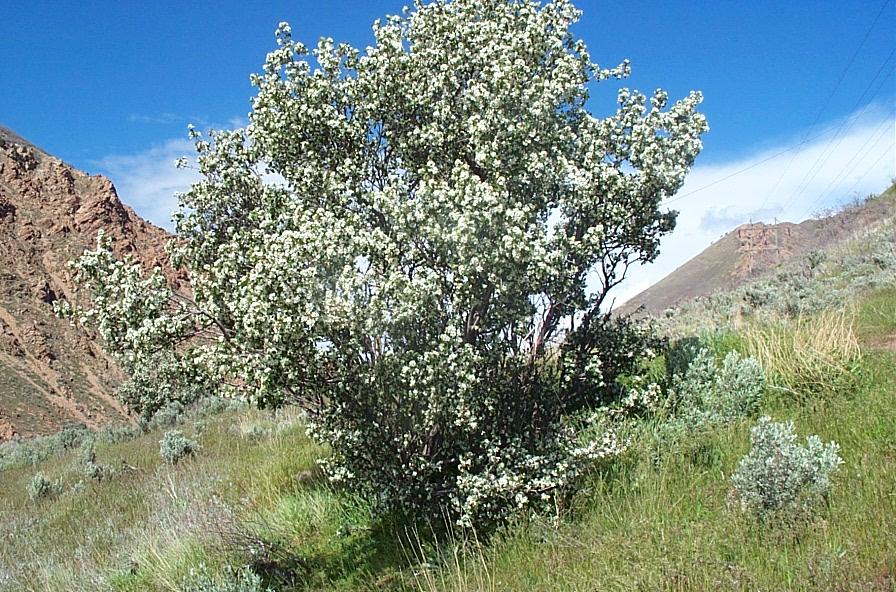
A. Utahensis in Salt lake County Utah courtesy of SEINet Arizona New Mexico Chapter photo by Tony Frates
There is no doubt that native flowering plants in the southwestern United States often endure difficult growing conditions in their natural habitat. But just as baffling, many of these plants seem to demand such harshness. Are they beautiful because of these hardships or in spite of it? Regardless of the answer, the Utah serviceberry (Amelanchier utahensis) is attractive no matter if it is enduring the elements of the back country or reaping the benefits of tender loving care in the back yard.
Thriving in elevations of 5,000 to 9,000 feet, the deciduous, perennial Utah serviceberry is native to a large portion of the dry northwestern and southwestern regions of the United States, and dipping into northern Mexico. Its natural habitat varies from the rough and tumble environment of mesas, canyons, rocky slopes, scrublands and along roadsides to cozy woodlands where it resides among stands of piñon-juniper and aspen trees. Because of its visual appeal and hardiness in USDA zones 5-8, this member of the Rosaceae (rose) family has also adapted to the more genteel locations of home and public gardens in areas both in and and outside its native regions.
In April and May the Utah serviceberry quickly gets down to the business of chasing away the winter doldrums. Finely serrated, green leaves alternately line the young, reddish growth and the soft gray of the smooth, mature branches. Racemes of white flowers cover the plant from base to tip of each branch. It is the flowering and fruit stages where the Utah serviceberry reveals its connection with the rose family. Its white, rose-like flowers consist of 5 petals that pinwheel around a circle of multiple stamens with two styles in the center. After the petals fade, bouquets of stamens hang around a while to extend the blooming phase before morphing into the fruit. Attractive, green clusters of rose-hip shaped fruit eventually turn to a pink or dark purple hue. These edible, plump, juicy fruits are commonly known as serviceberries. They remain on the plant throughout the summer and into autumn where they contrast with the golden foliage. Even during parts of the winter months it is not unusual for the fruits to be seen adorning the leafless branches IF the birds haven’t eaten them yet.
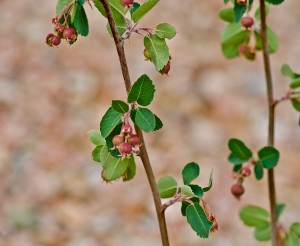
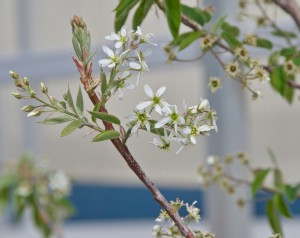
Because of its long-term visual attractions from leaves to flower to fruit, it is no wonder that the Utah serviceberry has been enthusiastically embraced by gardeners in the Santa Fe area. It is pretty, tough and loves our climate. The rounded growth habit has the versatility to be grown as a shrub or a small tree. For those with limited space, the Utah serviceberry offers a botanical touch to portals, patios and entrances when potted in an attractive container large enough to accommodate future growth. And because it can achieve a maximum height of up to 15 feet, it may be necessary to eventually transplant it to a more permanent location in the ground. The Utah serviceberry will appreciate a sunny or partially shaded spot with enough room to for it to reach a width of up to 10 feet. Allow its slow-growing but deep root system to freely spread in sandy, well-draining soil with a low saline content. The Utah serviceberry does not like a high water table and is drought resistant. But it will thank you for supplying a bit of supplemental water when Mother Nature gets stingy with rainfall.
As with many native plants, the Utah serviceberry believes in payback to its environment. In the hinterlands or wide open country, the Utah serviceberry’s branches and leaves are browsed by game and livestock. Best to remember that if your garden is located where deer and antelope roam. The flowers’ sweet nectar attracts pollinators such as bees, butterflies and other insects. The shrubby growth offers protective cover and nesting materials for birds and small mammals. If you intend to harvest the fruit for your personal pantry, prepare to race the birds when the serviceberries are ripe for the picking. Be warned….birds really, really like the Utah serviceberry fruit and they usually take the checkered flag in that contest.
Curiosity is often piqued when trying to determine the reason behind both scientific and common plant names. The genus, Amelanchier, is French for “Alnifolia”, defined as “alder-like foliage”. Bernhard Adalbert Emil Koehne, a German botanist (1848-1918), named the species utahensis – defined as “from Utah” – after examining a 1890’s specimen collected in Utah by Marcus E. Jones, an American geologist, mining engineer and botanist (1852-1934). The definitions of the scientific names are clear and make sense, right?
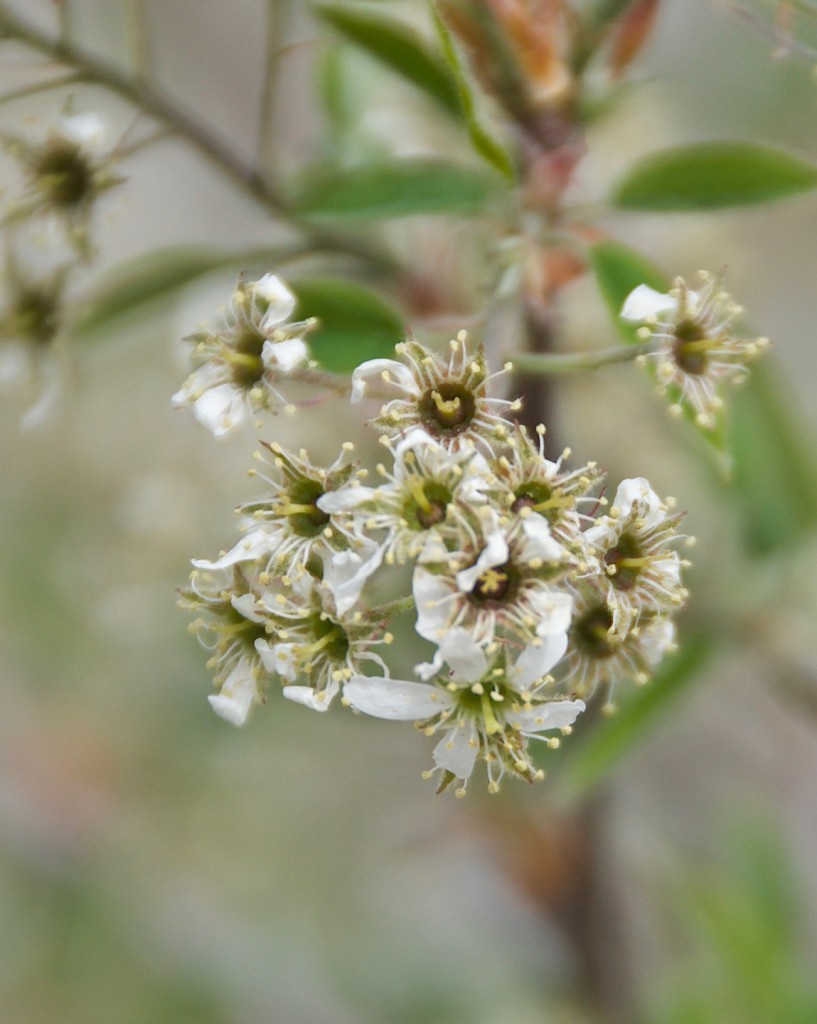 However, it is the common name of serviceberry, which is shared among the Amelanchier species, that begs definition. The “berry” part is fairly easy to grasp since the fruit can be considered as berry-like. But why “service”? Official definitions are rather vague and nonsensical. An old legend that seems to have originated with early eastern settlers in our country addresses the “service” portion of the name. This legend is not validated by any consulted sources but then common plant names do not abide by the rules of scientific taxonomy. Besides, old legends die hard and often add a charming touch to a plant’s common name. The short version of the story is as follows: These early settlers whose loved ones had passed away during the frigid winter months had to wait until the ground had thawed enough to dig graves. Understandably, this chore was carried out as soon as possible. Early spring offered a limited supply of blooming plants. The serviceberry, which produces a shrub full of flowers, was often chosen as the flowers for the burial service. Thus the name “service” berry. Actually the legend is not so far-fetched when one considers the bouquet formation of the racemes. The serviceberry’s natural floral arrangement would be fitting for several rites of passage from christenings to weddings as well as for burial ceremonies.
However, it is the common name of serviceberry, which is shared among the Amelanchier species, that begs definition. The “berry” part is fairly easy to grasp since the fruit can be considered as berry-like. But why “service”? Official definitions are rather vague and nonsensical. An old legend that seems to have originated with early eastern settlers in our country addresses the “service” portion of the name. This legend is not validated by any consulted sources but then common plant names do not abide by the rules of scientific taxonomy. Besides, old legends die hard and often add a charming touch to a plant’s common name. The short version of the story is as follows: These early settlers whose loved ones had passed away during the frigid winter months had to wait until the ground had thawed enough to dig graves. Understandably, this chore was carried out as soon as possible. Early spring offered a limited supply of blooming plants. The serviceberry, which produces a shrub full of flowers, was often chosen as the flowers for the burial service. Thus the name “service” berry. Actually the legend is not so far-fetched when one considers the bouquet formation of the racemes. The serviceberry’s natural floral arrangement would be fitting for several rites of passage from christenings to weddings as well as for burial ceremonies.
Santa Fe’s Botanical Garden at Museum Hill has lovely specimens of the Utah serviceberry. The potted plant in front of the Visitor’s Center welcomes all who come to the Garden. And it grows among other native plants in the lower Sunrise Classroom of the Ojos y Manos sector.
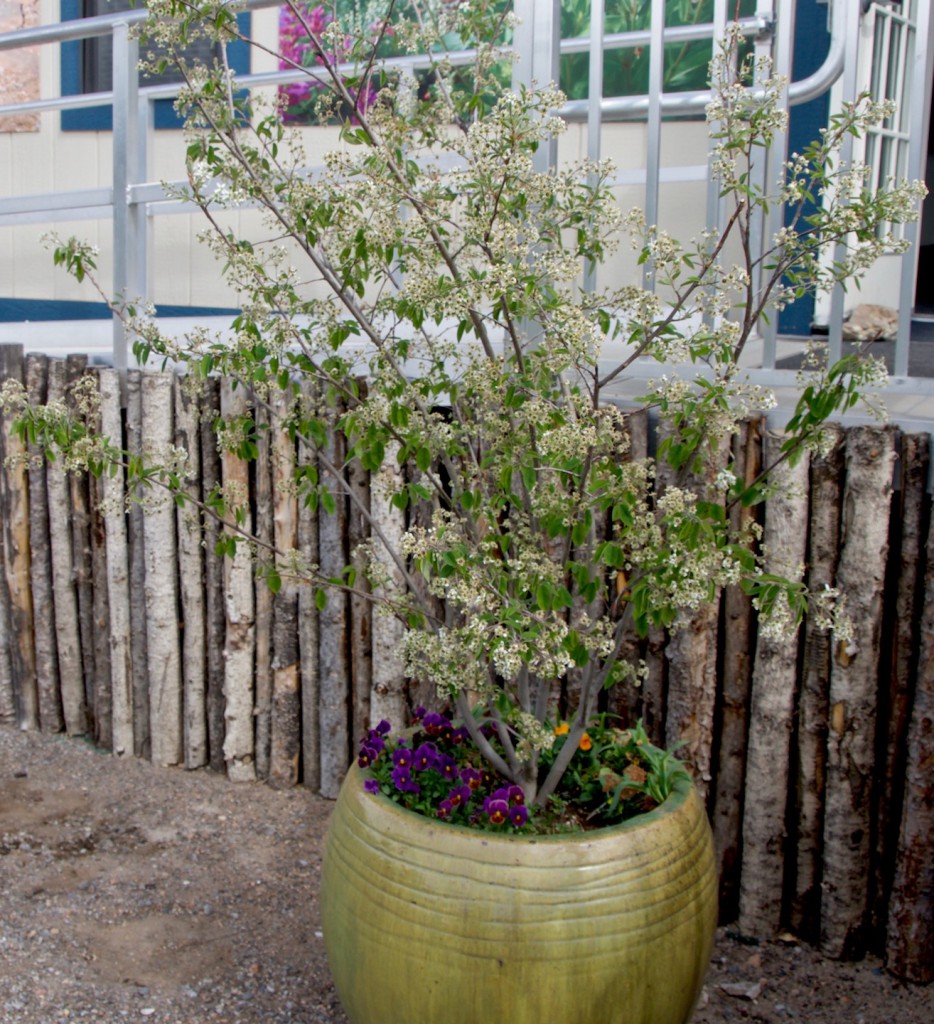
The Utah serviceberry (Amelanchier utahensis) is a rewarding choice for any garden, especially one that focuses on native plant species. Think about it. How many plants offer up flowering bouquets in the spring, attractive, tasty fruits in the summer that remain through most of winter, and golden fall color? But let’s not forget its perseverance in a challenging environment. If we consider the Utah serviceberry a plant that laughs in the face of adverse growing conditions, then how ‘bout we raise a glass to adversity!
Thanks to Helen Woody and Jeanne Gozigian for proofreading this article.
Sources consulted and/or cited:
Lady Bird Johnson Wildflower Center website, Amelanchier utahensis.
Salman, David, High Country Gardens website, Amelanchier utahensis/Utah Service Berry.
SEINet Arizona-NewMexico Chapter website, text and photograph, Amelanchier utahensis Koehne – Photo citation: SEINet-Arizona -New Mexico Chapter.
- http//:swbiodiversity.org/seinet/index.php. Accessed February 25, 2018. Photo by Tony Frates.
Schneider, Al , Southwest Colorado Wildflowers website, Amelanchier alnifolia and Amelanchier utahensis.
USDA/NRCS Plant Guide webpage, Utah Serviceberry Amelanchier utahensis Koehne.
Wikipedia website – for biographical information on Koehne and Jones.


